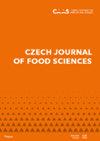蜂蜜酒和甜点的特征参数
IF 1
4区 农林科学
Q4 FOOD SCIENCE & TECHNOLOGY
引用次数: 1
摘要
本研究的目的是评估17种蜂蜜酒样品的化学成分,这些样品原产于捷克共和国。这些样品包括蜂蜜酒(仅由水和蜂蜜制成)和主要通过添加糖或酒精处理的甜点。分析了以下化学参数:乙醇、无糖提取物、羟甲基糠醛(HMF)、糖(单糖、双糖)、有机酸、可同化氮和多酚。样品间存在显著差异:1)葡萄糖和果糖含量分别为2.5 ~ 113.1 g L-1和17.3 ~ 136.3 g L-1;HMF含量在1.0 ~ 87.7 mg L-1之间。有机酸含量最高的是乳酸(平均1.0 g L-1)、葡萄糖酸(0.6 g L-1)和乙酸(0.4 g L-1);酚类化合物含量为151.9 ~ 385.3 mg没食子酸当量(GAE) L-1。蜂蜜酒通常含有葡聚糖(2.0-7.6 g L-1)和海藻糖(1.1-10.1 g L-1),而甜点蜜酒的特点是蔗糖含量增加(高达76.5 g L-1)。本文章由计算机程序翻译,如有差异,请以英文原文为准。
Characteristic parameters of honey wines and dessert meads
The aim of this study was to evaluate the chemical composition of 17 samples of mead originating from the Czech Republic. The samples included honey wines (made only from water and honey) and dessert meads which were treated mainly by the addition of sugar or alcohol. The following chemical parameters were analysed: ethanol, sugar-free extract, hydroxymethylfurfural (HMF), sugars (monosaccharides, disaccharides), organic acids, assimilable nitrogen, and polyphenols. Substantial differences were found between samples: i) the content of glucose and fructose was 2.5–113.1 g L–1 and 17.3–136.3 g L–1, respectively; ii) the HMF content ranged from 1.0 mg L–1 to 87.7 mg L–1. The most abundant organic acids were lactic acid (average 1.0 g L–1), gluconic acid (0.6 g L–1), and acetic acid (0.4 g L–1); the amount of phenolic compounds was 151.9–385.3 mg gallic acid equivalent (GAE) L–1. Honey wines typically contained turanose (2.0–7.6 g L–1) and trehalose (1.1–10.1 g L–1), while dessert mead was characterised by an increased sucrose content (up to 76.5 g L–1).
求助全文
通过发布文献求助,成功后即可免费获取论文全文。
去求助
来源期刊

Czech Journal of Food Sciences
Food Science & Technology, Chemistry-食品科技
CiteScore
2.60
自引率
0.00%
发文量
48
审稿时长
7 months
期刊介绍:
Original research, critical review articles, and short communications dealing with food technology and processing (including food biochemistry, mikrobiology, analyse, engineering, nutrition and economy). Papers are published in English.
 求助内容:
求助内容: 应助结果提醒方式:
应助结果提醒方式:


